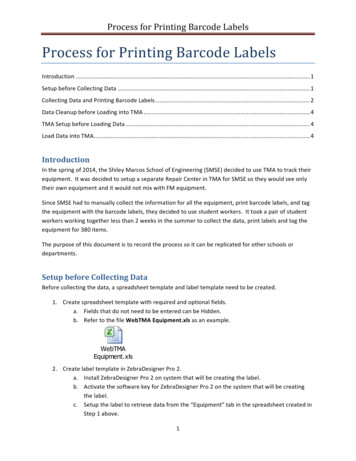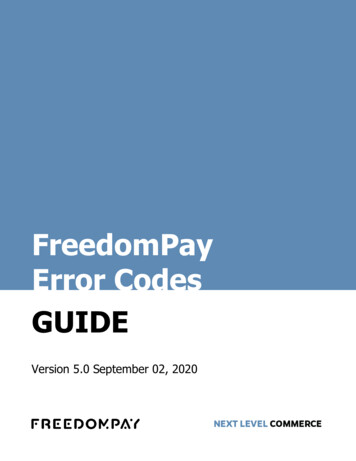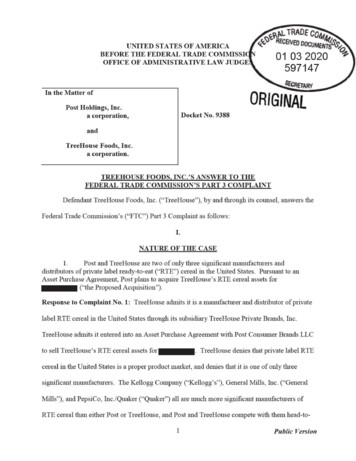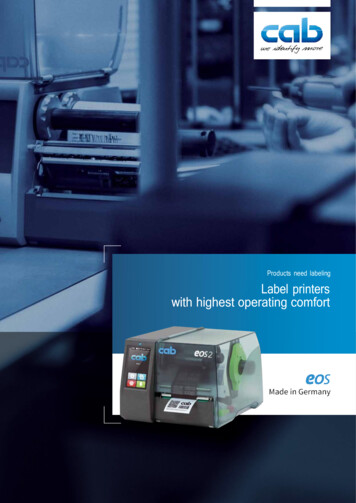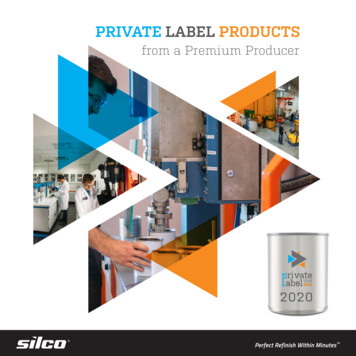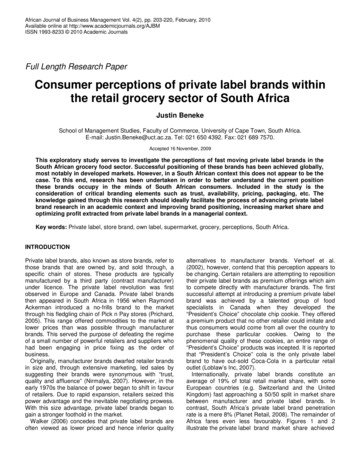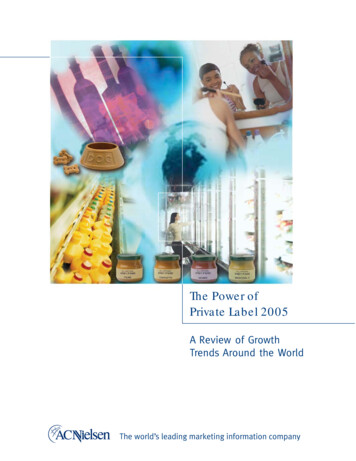
Transcription
The Power ofPrivate Label 2005A Review of GrowthTrends Around the WorldThe world’s leading marketing information company
THE POWER OF PRIVATE LABEL 2005A Review of Growth Trends Around the WorldTABLE OF CONTENTS¾Executive Summary2¾Geographic Insights9¾Category Insights13¾Pricing Trends17¾Private Label Consumers22¾Methodology28The information contained in this report has been collected from ACNielsenin 38 countries around the world. For questions or to obtain more detailedinformation by country please contact your local ACNielsen Global Servicesrepresentative or contact either of the authors, Clare Nishikawa atclare.nishikawa@acnielsen.ca or Jane Perrin at jane.perrin@acnielsen.com.The information contained in this report is not to be used with sourcesoutside of your company without the express written permission ofACNielsen Global Services.Copyright 2005 ACNielsen. All rights reserved. ACNielsen and ACNielsen with globe designare trademarks or registered trademarks of AC Nielsen (US), Inc. Other brand and productnames are trademarks or registered trademarks of their respective companies.Executive News Report from ACNielsen Global ServicesSeptember 20051
THE POWER OF PRIVATE LABEL 2005A Review of Growth Trends Around the WorldEXECUTIVE SUMMARYHow big is the Private Label market globally? Why is Switzerland the largest market?Could the Private Label business become as big in the United States as it is inSwitzerland? What’s happening in the developing markets? Looking across categories,where is Private Label most prevalent? Is Private Label expanding into new categories?The Power of Private Label starts to answer these questions by looking at the latest PrivateLabel information from across the globe. Alongside a review of current trends in 38 countriesand 80 categories, this study looks at the market dynamics that have created a haven forPrivate Label development across countries. Such factors as retailer concentration and thepresence of discounters have played a significant role in the development of these products.The growing level of sophistication among retailers in marketing and product development,along with the added resources they are putting into cultivating their own brands are othercontributing factors. In this study we have also included a look at the history and development ofa couple of very successful Private Label brands.In addition to looking at sales in retail stores, we have included consumer panel data from 14countries. The Power of Private Label closely examines the people that buy Private Label:Who are they? How often do they purchase Private Label? How much do they spend onPrivate Label? Do they purchase the same way across countries?THIRTY-EIGHT COUNTRIES AND 80 CATEGORIESThe Power of Private Label reviews the level of development and growth of Private Labelproducts in 38 countries around the world. From a channel coverage perspective, sales withinsupermarkets, hypermarkets and mass merchandisers are generally included (althoughcoverage varies dependent on the market). In a number of countries, convenience stores anddrug stores are included as well. For the most part, department stores and cash and carryoutlets, as well as wholesalers and food service outlets are generally excluded.To illustrate the overall impact of Private Label activity, we have examined sales across 80distinct categories and 14 different product areas. In addition, we have taken a look at a coupleof smaller, more dynamic categories (identified in ACNielsen’s 2004 series of What’s Hotreports as the fastest growing categories globally) to see if Private Label has made anysignificant in-roads into these growth areas. It is important to note that coverage of categorieswithin markets depends on data availability within each country. (Details of the number ofcountries included for each category can be found in the methodology section at the end of thereport.)Due to differences in volumetric measures across countries, value sales were used in theanalysis and then converted to US dollars for comparison purposes.Executive News Report from ACNielsen Global ServicesSeptember 20052
THE POWER OF PRIVATE LABEL 2005A Review of Growth Trends Around the WorldTOP FIVE PRIVATE LABEL COUNTRIES LOCATED IN EUROPEAcross the 38 countries and 80 categories included in this study Private Label sales accountedfor 17% of the value sales over the 12 months ending the first quarter of 2005. In comparison toyear ago, Private Label sales grew by 5%.Europe maintained its position as the most developed Private Label region with an aggregatedPrivate Label share in value sales of 23% for the 17 European countries included in the study.As with our 2003 study, the European countries of Switzerland, Germany, Great Britain, Spainand Belgium were the five countries with the highest Private Label shares.North America, which ranked second in regional Private Label shares, saw a significant growthof Private Label sales, up 7%. The share of Private Label in this region is currently at 16%.Although starting from a smaller base, Private Label in the Emerging Markets saw the fastestgrowth over the last year, up 11%. Private Label now holds a 6% share of sales in the EmergingMarkets. This growth was primarily driven by the increasing strength of the modern trade (wherePrivate Label goods are more prevalent), as well as the entry of Private Label products into newcategories.SHARE AND GROWTH RATES OF PRIVATE LABEL BY REGION(BASED ON VALUE SALES)PL SHAREGlobalPL GROWTHGlobal17%Europe23%North 4%Latin AmericaEuropeNorth America6%Asia Pacific5%10%15%20%25%11%Asia Pacific5%Latin America5%0%2%4%6%8%10%12%Executive News Report from ACNielsen Global ServicesSeptember 20053
THE POWER OF PRIVATE LABEL 2005A Review of Growth Trends Around the WorldEUROPEAN PRIVATE LABEL SALES EXPERIENCED GREATEST MARKET SHARE GAINIn comparison to year ago, global Private Label sales grew by 5%, outpacing manufacturerbrands (growing by only 2%). The result was a global gain of 0.4 share points for Private Labelversus the previous year. In fact, growth in Private Label sales outpaced manufacturer brands inevery region except for Latin America. (In general, Latin America continues to be a far lessdeveloped Private Label market than the rest of the world.) The result was that Private Label inLatin America lost 0.1 points versus manufacturer brands.Interestingly, the region with the most developed Private Label market saw the greatest gain inshare points. Private Label sales grew in Europe by 4%, while aggregated sales ofmanufacturer brands remained flat. The result was a gain of 0.7 share points for Private Label.This growth is illustrative of the fact that sales of Private Label have not peaked even withinthe largest Private Label markets.REFRIGERATED FOOD HAD THE HIGHEST SHARE OF PRIVATE LABELAcross product areas, Paper Products, Plastic Bags & Wraps has traditionally been thestrongest product area for Private Label sales (as seen in our 1998 and 2003 studies). AlthoughPrivate Label shares in this product area are still strong, now at 31%, and continue toexperience growth, Private Label Refrigerated Food now tops the list, with an aggregated shareof value sales of 32%. The most significant share of Private Label sales within this area wasseen within the Refrigerated Complete Ready Meals category (Private Label had a value shareof 47%). Retailer development of Private Label brands to meet the needs of their shoppers forconvenient meal alternatives has resulted in the growth of this category.As seen in our previous studies, Private Label shares within the areas of Personal Care,Cosmetics and Baby Food were the smallest at less than 5%.PRIVATE LABEL SHARES AND GROWTH RATES BY PRODUCT AREA(BASED ON VALUE SALES)PRODUCT AREAPL SHAREPLGROWTHPRODUCT AREAPL SHAREPLGROWTH1Refrigerated Food32%9%8Non-Alcoholic Beverages12%3%2Paper, Plastic & Wraps (PPW)31%2%9Home Care10%2%3Frozen Food25%3%10Snacks & Confectionery9%8%4Pet Food21%11%11Alcoholic Beverages6%3%5Shelf-Stable Food19%5%12Personal Care5%3%6Diapers & Feminine Hygiene14%-1%13Cosmetics2%23%7Health Care14%3%14Baby Food2%13%Executive News Report from ACNielsen Global ServicesSeptember 20054
THE POWER OF PRIVATE LABEL 2005A Review of Growth Trends Around the WorldPRIVATE LABEL BRANDS PRICED A THIRD LOWER THAN MANUFACTURER BRANDSOn a global basis, across all of the 38 countries and 80 categories studied, Private Labelproducts were priced, on average, 31% lower than their manufacturer counterparts. Thevariance across regions ranged from 40% lower in the Emerging Markets to 25% lower in LatinAmerica and Asia Pacific. It is interesting to note that the two least developed regions (from aPrivate Label perspective), also had the smallest price differential versus manufacturer brands.On a category basis, the average price differential ranged from Private Label being priced 46%lower in Personal Care products to just 16% lower for Refrigerated Food. At the individualcountry/category level, however, there were a number of examples where Private Labelproducts had an average price that was actually higher than the manufacturer brands. Onereason for this was the presence of ‘premium’ Private Label products. In addition, severalcountries cited intense promotional price “wars” among manufacturers as a contributing factor tolower manufacturer price points.It is interesting to note that there is not a direct correlation between lower price and largestshare. Of the five product areas with the smallest price differential in comparison tomanufacturer brands, three had the largest share of Private Label and two had the smallest.Refrigerated FoodFrozen FoodCosmeticsPaper, Plastic &WrapsBaby FoodSnacks &ConfectioneryAlcoholicBeveragesShelf-Stable FoodNon-AlcoholicBeveragesDiapers &Feminine HygieneHome CareHealth CarePet FoodPersonal CarePRIVATE LABEL PRICE DIFFERENTIAL VERSUS MANUFACTURER BRANDS0%-5%-10%-15%-16%-20%-20% -20%-25%-27%-30%-35%-37%-40%-24% -24%-32%-42%-45%-50%-36%-34%-26% -26%-46%Executive News Report from ACNielsen Global ServicesSeptember 20055
THE POWER OF PRIVATE LABEL 2005A Review of Growth Trends Around the WorldRETAILER CONCENTRATION A KEY FACTOR IN PRIVATE LABEL DEVELOPMENTIn order to study the impact of retailer concentration on the development of Private Label, welooked at the share of total country value sales held by the leading five retailers within eachcountry. Interestingly, there is significant variation in this measure around the world. Forexample, in the European countries of Sweden and Finland the top five retailers account fornearly 100% of total country sales, whereas in the Asian countries of South Korea and Japan,the leading retailers hold only 12% of total sales.Not surprisingly, the level of retailer concentration was closely aligned with the level of PrivateLabel development. Of the top ten countries (ranked by share of Private Label), nine countrieshad retailer concentration of over 60%. The only exception in this group was the United Stateswhose retail environment was far more fragmented. Ranking 10th in share of Private Labelsales, the United States ranked 30th in retailer concentration. The top five retailers in the UnitedStates accounted for only 36% of total country sales. The majority of other countries with such afragmented retailer landscape had a far less developed Private Label market.DISCOUNTERS CONTINUED TO PLAY A SIGNIFICANT ROLEA contributing factor to Private Label growth, particularly in Europe, was the growing presenceof Hard Discounters. Hard Discounters sell a very limited selection of products (primarily shelfstable food) at a very low price. More importantly (for this study), hard discounters mostly sellPrivate Label products. For example, within Aldi, Private Label products account forapproximately 95% of sales. Hard Discounters such as Aldi and Lidl are present in everyEuropean country and are expanding this presence. As hard discounters continue to grow andgain share, with more stores and wider consumer acceptance, so does Private Label.RETAILERS CREATE POWERFUL BRANDS THAT MEET CONSUMER NEEDSThe approach of retailers to Private Label, particularly in the more developed markets, hasadvanced far beyond simply meeting the consumer’s need for lower priced products (the moretraditionally perceived role of the Private Label brand). Retailers such as Tesco in Great Britainand Loblaws in Canada, for example, have both added new private label offerings to their mix.In addition to continuing to offer a ‘value’ or ‘no frills’ option, they also now offer healthy PrivateLabel lines for both adults and kids.Executive News Report from ACNielsen Global ServicesSeptember 20056
THE POWER OF PRIVATE LABEL 2005A Review of Growth Trends Around the WorldCONSUMERS – WHO REALLY BUYS PRIVATE LABEL?NEARLY EVERYONE Looking at consumer panel data from 14 countries, it was found that thepenetration of Private Label was significant. In fact, in nine of the 14 countries, 100% ofhouseholds had purchased Private Label products over the past year. Penetration was thesmallest in Singapore, but even there, 77% of households purchased at least some PrivateLabel products within the last year.EIGHTY-TWO PERCENT OF BRITISH SHOPPING TRIPS INCLUDED PRIVATE LABELPRODUCTSFrequency of purchase was found to be a key driver of Private Label share. Looking acrosscountries, consumers purchased Private Label products at varying degrees. Those countrieswith the highest Private Label share were found to purchase Private Label goods most often.Consumers in Great Britain (with a Private Label share of 28%), were found to have PrivateLabel products in their basket on 82% of their shopping trips. Private Label consumers in lessdeveloped markets generally purchased Private Label products on only 16% of their shoppingtrips.PRIVATE LABEL CONSUMERS RANGE FROM THE YOUNG TO THE OLD, THE RICH TOTHE POOR AND FROM SINGLES TO LARGE FAMILIESLooking across consumers and households, Private Label purchasing varied based ondemographic composition.Income: The share of spend allocated to Private Label products was generally higher in thosehouseholds with a lower household income.Household Size: Households with more family members allocated a higher share of their totalspend to Private Label products.Age: On trying to identify the ‘typical’ age of the Private Label consumer, there was no cleartrend that held true across regions.HOW BIG WILL PRIVATE LABEL GROW?The limits of Private Label are currently undetermined but it seems almost certain that they havenot been reached.In a number of countries, category penetration of Private Label is still significantlyunderdeveloped. As Private Label offerings are expanding into new markets and categories,global share will of course grow. For example, in Switzerland, where 97% of all the categoriestracked in this study had Private Label entries, the total Private Label share was high at 45%. Inthe Philippines, however, where only 26% of the categories tracked had a Private Labelpresence, the share for Private Label was less than a percentage point.Executive News Report from ACNielsen Global ServicesSeptember 20057
THE POWER OF PRIVATE LABEL 2005A Review of Growth Trends Around the WorldHow big will it grow? Today, Private Label has a 17% share of market globally and it is stillgrowing. Even in the most developed market of Switzerland, Private Label continues to extendits reach. (In the last year, Private Label in Switzerland gained yet another share point).The differential between the 17% global share and Switzerland’s high of 45% is a good place tobegin our predictions for the future. Somewhere in between these two percentages is theanswer but it is important to note that as the share in Switzerland grows so does the upperboundary of this range.As retailers with strong Private Label offerings expand their reach across categories andcountries, Private Label will continue to challenge the position of branded products in the mindsof the consumers. How high they will grow is yet to be determined.Executive News Report from ACNielsen Global ServicesSeptember 20058
THE POWER OF PRIVATE LABEL 2005A Review of Growth Trends Around the WorldDETAILED FINDINGSGEOGRAPHIC INSIGHTSThe Power of Private Label looked at retail sales across 38 countries (encompassing Europe,North America, Asia Pacific, the Emerging Markets and Latin America) and 80 categories.Private Label value sales and share across these markets and categories grew, with 17 dollarsout of every 100 being spent on Private Label products. In 2003, Private Label share was foundto be only 15%.As seen in the table below, the strength of Private Label varied widely across the countriesincluded in the study, from Switzerland (with a Private Label share of 45%), to the Philippines(where Private Label sales hold an insignificant share of total country sales).VALUE SHARES OF PRIVATE LABEL BY COUNTRYCOUNTRYREGIONPL SHARECOUNTRYREGIONPL SHARE1SwitzerlandEurope45%20 NorwayEurope8%2GermanyEurope30%21 IrelandEurope7%3Great BritainEurope28%22 Czech RepublicEmerging Markets7%4SpainEurope26%23 Hong KongAsia Pacific4%5BelgiumEurope25%24 BrazilLatin America4%6FranceEurope24%25 GreeceEurope4%7NetherlandsEurope22%26 South AfricaEmerging Markets4%8CanadaNorth America19%27 Puerto RicoLatin America4%9DenmarkEurope17%28 JapanAsia Pacific4%10 United StatesNorth America16%29 IsraelEurope3%11 SwedenEurope14%30 SingaporeAsia Pacific3%12 AustriaEurope14%31 ChileLatin America3%13 New ZealandAsia Pacific12%32 ArgentinaLatin America3%14 ItalyEurope11%33 ColombiaLatin America2%15 PortugalEurope11%34 CroatiaEmerging Markets2%16 HungaryEmerging Markets10%35 ThailandAsia Pacific1%17 SlovakiaEmerging Markets10%36 MexicoLatin America1%18 FinlandEurope10%37 South KoreaAsia Pacific1%19 AustraliaAsia Pacific38 PhilippinesAsia Pacific 0.5%9%Executive News Report from ACNielsen Global ServicesSeptember 20059
THE POWER OF PRIVATE LABEL 2005A Review of Growth Trends Around the WorldAs in our 2003 study, the Emerging Markets, Asia Pacific and Latin America were again foundto have less developed Private Label markets than Europe and North America. In the EmergingMarkets, the strongest Private Label development was seen in Hungary and Slovakia wherePrivate Label sales accounted for 10% of total country sales. When looking across Asia Pacific,the Pacific countries of New Zealand and Australia had far more developed Private Labelmarkets than the Asian countries. New Zealand’s Private Label share was 12% and Australia’swas 9%. The Asian countries all had much smaller Private Label markets, accounting for 4% orless of total country sales. The highest ranking country in Latin America was Brazil, where only4% of sales were for Private Label products.Europe maintained its position as the most developed Private Label region. In fact, when the 38countries were ranked, based on Private Label share, eight of the top 10 highest-rankingcountries were in Europe. The other two were in North America. Both the United States andCanada were amongst the most developed countries in terms of Private Label share.EUROPE’S HIGH LEVEL OF RETAILER CONCENTRATION CORRELATES WITH STRONGPRIVATE LABEL DEVELOPMENTRetailer concentration was measured as the share of sales held by the top five retailers withineach country. Of the ten most developed Private Label countries, nine had retailerconcentrations over 60%. The United States was the only exception among this group - despitea more fragmented marketplace (with a retailer concentration of only 36%), its share of PrivateLabel was still among the top ten countries. Generally, across the countries, when retailerconcentration was low, the share of Private Label was also low.RETAILER CONCENTRATION OF THE MOST DEVELOPED PRIVATE LABEL MARKETSCOUNTRYREGIONPRIVATE 5%86%2GermanyEurope30%65%3Great 8CanadaNorth America19%62%Europe17%89%North America16%36%9Denmark10 United StatesExecutive News Report from ACNielsen Global ServicesSeptember 200510
THE POWER OF PRIVATE LABEL 2005A Review of Growth Trends Around the WorldPRIVATE LABEL GROWTH SEEN ACROSS ALL REGIONSAt the global level, aggregated Private Label sales for the last 12 months grew at 5%. At theregional level, the Emerging Markets saw the fastest growth of Private Label – up 11% sincelast year (albeit from a small base). This growth was attributed to the increasing strength of themodern trade (where Private Label products are far more prevalent), as well as the presence ofPrivate Label products in an increasing number of categories.At an individual country level, the ten countries experiencing the fastest growth of private labelwere drawn from a number of regions including the Emerging Markets, Europe, Asia Pacific andLatin America.The most surprising presence in the list below is that of Spain. Being a large developed countryin terms of total packaged goods sales and already having a Private Label share of 26%, Spainstill ranked among the top ten in Private Label growth. This strong growth was attributable to anumber of factors including: the expanded availability of Private Label products (as stores with afocus on Private Label opened more outlets), as well as further development and innovation ofPrivate Label offerings (such as anti-wrinkling products within face care).TOP TEN FASTEST GROWING PRIVATE LABEL MARKETSCOUNTRYREGIONPL GROWTHMANUFACTURERGROWTHPL SHARE1CroatiaEmerging Markets77%0%2%2GreeceEurope24%2%4%3ThailandAsia Pacific18%8%1%4ArgentinaLatin America18%22%3%5South KoreaAsia 6%6%26%8SingaporeAsia Pacific16%1%3%9ColombiaLatin America15%6%2%Emerging Markets15%5%10%10 HungaryExecutive News Report from ACNielsen Global ServicesSeptember 200511
THE POWER OF PRIVATE LABEL 2005A Review of Growth Trends Around the WorldPRIVATE LABEL CONTINUED TO GAIN SHARE MOST SIGNIFICANTLY IN EUROPEThe growth of Private Label brands over the last 12 months again outpaced that ofmanufacturer brands. As mentioned previously, aggregated Private Label sales for the last 12months grew globally at 5%, with manufacturer brands growing by only 2%. The result was again in Private Label share across the 38 countries of 0.4 share points. In two-thirds of thecountries studied (26 out of 38), Private Label brands were growing at a faster rate than theirmanufacturer counterparts.The most significant share gains for Private Label were in the developed Private Label region ofEurope. Private Label sales grew in Europe by 4%, while aggregated sales of manufacturerbrands remained flat. The result was a gain of 0.7 share points for Private Label.The share gains within Europe were driven by a number of countries. Looking globally at the tencountries with the largest Private Label share gains, seven were in Europe. For five of thoseseven countries, the growth rate of manufacturer brands was actually negative. In Spain, valuesales for both manufacturer brands and Private Label brands were growing but Private Labelgrowth was at twice the pace the result was a gain of 1.8 share points for Private Label.TOP TEN PRIVATE LABEL MARKETS BASED ON SHARE POINT GAINCOUNTRYREGIONPLGROWTHRATEMANUGROWTHRATEPL g 3%-2%1.07GermanyEurope3%-2%1.08CroatiaEmerging Markets77%0%0.89HungaryEmerging Markets15%5%0.8Europe14%1%0.810 NorwayA contributing factor to Private Label growth, particularly in Europe, was the growing presenceof Hard Discounters. Hard Discounters sell a very limited selection of products (primarily shelfstable food) at a very low price. More importantly (for this study), hard discounters mostly sellPrivate Label products. For example, within Aldi, Private Label products account forapproximately 95% of sales. Hard Discounters such as Aldi and Lidl are present in everyEuropean country and are expanding this presence. As hard discounters continue to grow andgain share, with more stores and wider consumer acceptance, so does Private Label.Executive News Report from ACNielsen Global ServicesSeptember 200512
THE POWER OF PRIVATE LABEL 2005A Review of Growth Trends Around the WorldCATEGORY INSIGHTSIn order to provide a fair representation of the role of Private Label across a wide range ofproduct areas, we chose a selection of 80 different categories within 14 different product areas.For example, within the larger product area of Refrigerated Food, six categories were chosen toprovide a perspective on this area: MilkYogurtButter/MargarineCheeseComplete Ready MealsMeat/Poultry/GameREFRIGERATED FOOD TAKES THE LEAD AS THE MOST DEVELOPED PRIVATE LABELPRODUCT AREARefrigerated Food, represented by the six categories cited above, had the highest overall shareof Private Label in the study, with an aggregated value share of 32% (see chart included in theExecutive Summary). Within this area, the Complete Ready Meals category had the highestPrivate Label share, with nearly half of the category sales (47%) made up of Private Labelproducts. The most significant Private Label shares for this category were found in Europe. InGreat Britain, for example, 97% of sales in the Refrigerated Complete Ready Meals categorywere for Private Label brands. Another significant Private Label category in Refrigerated Foodwas Milk, with 43% of sales accounted for by Private Label brands.In addition to Refrigerated Food, Frozen Food and Shelf-Stable Food also had a number ofentries in the top Private Label categories when ranked on share. In aggregated sales, each ofthese product areas had over 20% of sales accounted for by Private Label brands.As identified in the 2003 study, the Private Label stronghold in Paper Products, Plastic Bags &Wraps (PPW) was still evident. This product area ranked second in Private Label share at 31%.Furthermore, looking globally across all of the 80 categories studied, the category of AluminumFoil (a part of PPW) had the highest Private Label share at 49%. Penetration of Private Label inthis area across all of the countries was a significant contributor to share, with five of the sixcategories in this product area having Private Label products present in every country.Executive News Report from ACNielsen Global ServicesSeptember 200513
THE POWER OF PRIVATE LABEL 2005A Review of Growth Trends Around the WorldVALUE SHARES OF PRIVATE LABEL BY CATEGORYCATEGORYPRODUCT AREAPLSHARECATEGORYPRODUCT AREAPLSHARE1 Aluminum FoilPPW49%41 Fabric SoftenersHome Care13%2 Complete Ready MealsRefrigerated47%42 MouthwashPersonal Care13%3 MilkRefrigerated43%43 Pain ReliefHealth Care13%4 Garbage/Refuse BagsPPW40%44 WineAlcoholic Bev12%5 Meat/Poultry/GameFrozen39%45 MayonnaiseShelf-Stable12%6 Fish/ Shellfish/ SeafoodFrozen39%46 Wet SoupShelf-Stable12%7 VegetablesFrozen38%47 Breakfast Cereals - RTEShelf-Stable11%8 VegetablesShelf-Stable36%48 WhiskyAlcoholic Bev11%9 Kitchen Paper/TowelPPW33%49 Cleansing - Bath/ShowerPersonal Care10%10 CheeseRefrigerated33%50 Household CleanersHome Care10%11 Potato FriesFrozen32%51 Feminine Personal HygieneDiapers/Fem Hyg10%12 Plastic Wrap/RollsPPW31%52 Savory/Neutral CrackersShelf-Stable9%13 Cooking OilShelf-Stable30%53 Cereal/Fruit/Muesli BarsSnacks/Conf9%14 Toilet TissuePPW30%54 Drinking YogurtNon-Alco Bev9%15 Jam/Jelly/MarmaladeShelf-Stable28%55 ToothbrushesPersonal Care9%16 Meat/Poultry/GameRefrigerated28%56 Skin Tanning (Protection)Personal Care9%17 RiceShelf-Stable26%58 Laundry DetergentHome Care8%18 Facial TissuePPW24%57 Chips/CrispsSnacks/Conf8%19 Dry PastaShelf-Stable23%59 Carbonated BeveragesNon-Alco Bev8%20 Dog FoodPet Food22%60 Dry SoupShelf-Stable7%21 Butter/MargarineRefrigerated21%61 ChocolateSnacks/Conf7%22 Cat FoodPet Food20%62 Facial CleansingPersonal Care6%23 VodkaAlcoholic Bev19%63 Body MoisturizersPersonal Care6%24 Auto Dish DetergentHome Care19%64 Disposable RazorsPersonal Care6%25 Juices/Juice-Based DrinksNon-Alco Bev19%65 Fresheners/DeodorizersHome Care6%26 Ice Cream/Frozen YogurtFrozen18%66 Sports Energy DrinksNon-Alco Bev5%27 PizzaFrozen17%67 Hair StylingPersonal Care5%28 Disposable Baby DiapersDiapers/Fem Hyg17%68 Toilet SoapPersonal Care4%29 Toilet CareHome Care17%69 Eye ShadowCosmetics4%30 Complete Ready MealsFrozen16%70 After Shave PrepsPersonal Care3%31 Ketchup - Tomato BasedShelf-Stable16%71 Face MoisturizersPersonal Care3%32 Sweet Biscuits (Cookies)Snacks/Conf16%72 ShampooPersonal Care3%33 Flavored Milk DrinksNon-Alco Bev16%73 Insect ControlHome Care3%34 Self-Adhesive DressingsHealth Care16%74 Beer/Lager/AlesAlcoholic Bev3%35 YogurtRefrigerated15%75 DeodorantsPersonal Care3%36 WaterNon-Alco Bev14%76 ToothpastePersonal Care3%37 Cold RemediesHealth Care14%77 Baby FormulaBaby Food2%38 TeaNon-Alco Bev14%78 Lip Stick/GlossCosmetics2%39 CoffeeNon-Alco Bev13%79 Baby FoodBaby Food1%40 Hand Dish DetergentHome Care13%80 Chewing GumSnacks/Conf1%Executive News Report from ACNielsen Global ServicesSeptember 200514
THE POWER OF PRIVATE LABEL 2005A Review of Growth Trends Around the WorldAs with the Power of Private Label study released in 2003, the lowest level of Private Labeldevelopment was seen primarily in three product areas: Personal Care, Cosmetics and BabyFood. Interestingly, Personal Care Private Label products were available in most countries, butthe Private Label share was still only at 5% of value sales. For example, Shampoo Private Labelproducts were available in 37 of the 38 countries measured, but Private Label market share inthis category was limited to 3%.For Cosmetics, however, availability of Private Label products did limit the value share. LipStick/Gloss and Eye Shadow Private Label brands were only available in half of
of Private Label sales, up 7%. The share of Private Label in this region is currently at 16%. Although starting from a smaller base, Private Label in the Emerging Markets saw the fastest growth over the last year, up 11%. Private Label now holds a 6% share of sales in the Emerging Markets.


